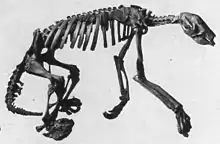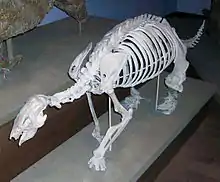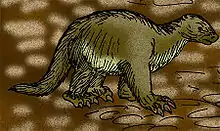Nothrotheriidae
Nothrotheriidae is a family of extinct ground sloths that lived from approximately 11.6 mya—11,000 years ago, existing for approximately 11.49 million years .[1] Previously placed within the tribe Nothrotheriini or subfamily Nothrotheriinae within Megatheriidae, they are now usually placed in their own family, Nothrotheriidae.[2] Nothrotheriids appeared in the Tortonian, some 11.6 million years ago, in South America. The group includes the comparatively slightly built Nothrotheriops, which reached a length of about 2.75 metres (9.0 ft). While nothrotheriids were small compared to some of their megatheriid relatives, their claws provided an effective defense against predators, like those of larger anteaters today.
| Nothrotheriidae | |
|---|---|
 | |
| Shasta ground sloth (Nothrotheriops shastense), Peabody Museum | |
| Scientific classification | |
| Kingdom: | Animalia |
| Phylum: | Chordata |
| Class: | Mammalia |
| Order: | Pilosa |
| Suborder: | Folivora |
| Family: | †Nothrotheriidae (Ameghino 1920) C. de Muizon et al. 2004 |
| Genera | |
|
See text | |
Evolution
During the late Miocene and Pliocene, the sloth genus Thalassocnus of the west coast of South America became adapted to a shallow-water marine lifestyle.[2][3][4] However, the family placement of Thalassocnus has been disputed; while long considered a nothrotheriid, one recent analysis moves it to Megatheriidae,[5] while another retains it in a basal position within Nothrotheriidae.[6]
The earliest nothrotheriid in North America was Nothrotheriops, which appeared at the beginning of the Pleistocene, about 2.6 Ma ago.[7] Nothrotherium reached Mexico (Nuevo Leon) by the late Pleistocene.[8]
The last ground sloths in North America belonging to Nothrotheriops died so recently that their dried subfossil dung has remained undisturbed in some caves (e.g., Rampart Cave in the Grand Canyon), as if it were just recently deposited. One of the skeletons, found in a lava tube (cave) at Aden Crater, adjacent to Kilbourne Hole, New Mexico, still had skin and hair preserved, and is now at the Yale Peabody Museum. The largest samples of Nothrotheriops dung can be found in the collections of the National Museum of Natural History.
Classification

Family †Nothrotheriidae (Ameghino 1920) C. de Muizon et al. 2004
- ?Subfamily Thalassocninae C. de Muizon et al. 2004[9]
- Genus Thalassocnus
- Subfamily Nothrotheriinae (Ameghino, 1920) C. de Muizon et al. 2004
- Genus Amphibradys
- Genus Chasicobradys
- Genus Huilabradys
- Genus Mionothropus
- Genus Nothropus
- Genus Nothrotheriops
- Genus Nothrotherium
- Genus Pronothrotherium
- Genus Xyophorus
Phylogeny
The following sloth family phylogenetic tree is based on collagen and mitochondrial DNA sequence data (see Fig. 4 of Presslee et al., 2019).[10]
| Folivora |
| |||||||||||||||||||||||||||||||||||||||||||||||||||||||||||||||||
References
- PaleoBiology Database: Nothrotheriidae, basic info
- Muizon, C. de; McDonald, H. G.; Salas, R.; Urbina, M. (June 2004). "The Youngest Species of the Aquatic Sloth Thalassocnus and a Reassessment of the Relationships of the Nothrothere Sloths (Mammalia: Xenarthra)". Journal of Vertebrate Paleontology. Society of Vertebrate Paleontology. 24 (2): 387–397. doi:10.1671/2429a. S2CID 83732878.
- de Muizon, C.; McDonald, H. G.; Salas, R.; Urbina, M. (June 2004). "The evolution of feeding adaptations of the aquatic sloth Thalassocnus". Journal of Vertebrate Paleontology. Society of Vertebrate Paleontology. 24 (2): 398–410. doi:10.1671/2429b. JSTOR 4524727. S2CID 83859607.
- Amson, E.; de Muizon, C.; Laurin, M.; Argot, C.; Buffrénil, V. de (2014). "Gradual adaptation of bone structure to aquatic lifestyle in extinct sloths from Peru". Proceedings of the Royal Society B: Biological Sciences. Royal Society of London. 281 (1782): 20140192. doi:10.1098/rspb.2014.0192. PMC 3973278. PMID 24621950.
- Amson, E.; de Muizon, C.; Gaudin, T. J. (2017). "A reappraisal of the phylogeny of the Megatheria (Mammalia: Tardigrada), with an emphasis on the relationships of the Thalassocninae, the marine sloths" (PDF). Zoological Journal of the Linnean Society. 179 (1): 217–236. doi:10.1111/zoj.12450. Archived from the original (PDF) on 2018-06-12.
- Varela, L.; Tambusso, P.S.; McDonald, H.G.; Fariña, R.A.; Fieldman, M. (2019). "Phylogeny, Macroevolutionary Trends and Historical Biogeography of Sloths: Insights From a Bayesian Morphological Clock Analysis". Systematic Biology. 68 (2): 204–218. doi:10.1093/sysbio/syy058. PMID 30239971.
- PaleoBiology Database: Nothrotheriops, basic info
- PaleoBiology Database: Nothrotherium, basic info
- A 2017 phylogenetic study moves this subfamily to Megatheriidae,[5] while a 2019 study retains it in Nothrotheriidae.[6]
- Presslee, S.; Slater, G. J.; Pujos, F.; Forasiepi, A. M.; Fischer, R.; Molloy, K.; Mackie, M.; Olsen, J. V.; Kramarz, A.; Taglioretti, M.; Scaglia, F.; Lezcano, M.; Lanata, J. L.; Southon, J.; Feranec, R.; Bloch, J.; Hajduk, A.; Martin, F. M.; Gismondi, R. S.; Reguero, M.; de Muizon, C.; Greenwood, A.; Chait, B. T.; Penkman, K.; Collins, M.; MacPhee, R.D.E. (2019). "Palaeoproteomics resolves sloth relationships" (PDF). Nature Ecology & Evolution. 3 (7): 1121–1130. doi:10.1038/s41559-019-0909-z. PMID 31171860. S2CID 174813630.
External links
| Wikispecies has information related to Nothrotheriidae. |

